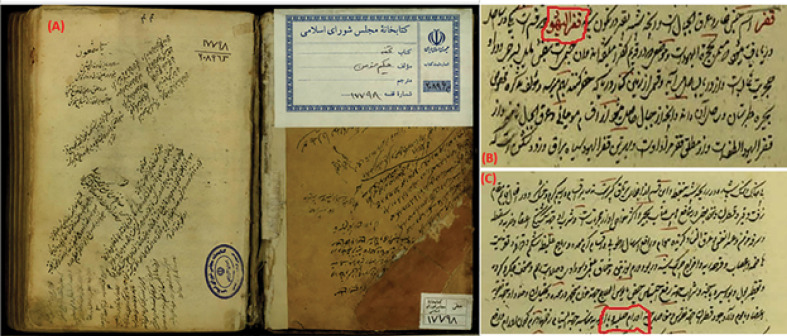Figure 1.
The ancestor document that represents the mummy therapeutic effects on cancer treatment. (A) represents the old handwritten book named Tohfeh, and panels (B) and (C) illustrate the text in the Tohfeh book that shows the mummy and cancer meaning into the red box, respectively.
Figure-1 documents translation
The nature of the mummy is something like bitumen coming out of the crevices of some of the mountains, most prominently in the Darab Mountains of the Fars province in Iran and later in the Mountains of Estahban and Kohgiluyeh in Iran.
There are many drugs in the history of pharmacology that are classified into three categories as herbal, animal, and mineral.
One of the types of mineral medicines widely used by physicians from the ancient to the late middle ages to treat various diseases is “mummy”.
In the first century AD, Dioscorides found medicinal mummies from the coast of Apollonia useful for epilepsy and inflammatory and sciatica diseases (Al-Hashayesh of Dioscorides, p.173).
Claudius Galenus also found mummies to be useful in skin diseases.
In al-Nabat’s book of Dinavari and Ferdows al-Hikmah of Tabari, p.333 and p.405 respectively, mummies are useful for the treatment of fractures and wound healing.
Razi, a famous Persian physician, wrote an independent book on the mummy subject and repeatedly used mummies to treat his patients. He had prescribed mummies for trauma, pain relief, fractures, injuries, headaches, tonic, brain tonic, earache, asthma, spleen pain and pediatric seizures (The medical treatises of Razi Pages 6 to 12, al-Hawi p. 82, al-Mansouri al-teb, p.177)
In the tenth century, Ahwazi in the book of Kamel al-Sana’e considered mummy to be beneficial for cold headache, hemoptysis, asthma, and withdrawal of the dead fetus (Vol. 3, p. 206).
Avicenna, a famous Persian physician, in his famous book, Qanoon found mummies very effective in brain tonic, fertility, and many other diseases. (Vol. 2, p. 17)
In the 12th century, a Persian book called Zakhire Khwarazmshahi was written by Jorjani, a renowned Persian physician, who found mummies to be very useful for inflammation, ulcers, urinary problems, and prostates (p. 624, p. 815, p. 818).
Ibn Nafis, known in the thirteenth century for his discovery of blood circulation, considered mummies to be beneficial for cancers. A book by al-Adawiyah, written by Aghili Khorasani in the 16th century, one of the most famous books on pharmacology in Persian medicine, mentioned the treatment of various types of tumors, both benign and malignant, by mummies.
In the 14th-century, in the book of Hakim Momen, mummies are useful for kidney stones and bladder, amenorrhea, and cataract treatment. The use of mummies to the bite of insects, snakes, and scorpions, sciatica pain, benign and malignant tumors have also been found useful. Mummy is even recommended for the treatment of some skin diseases such as psoriasis.

